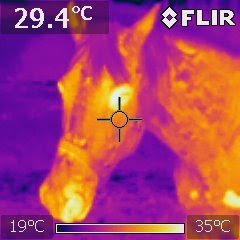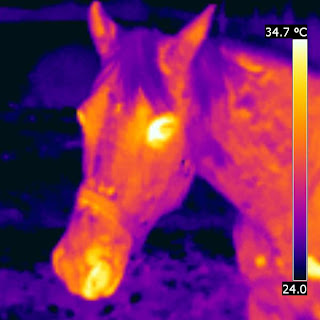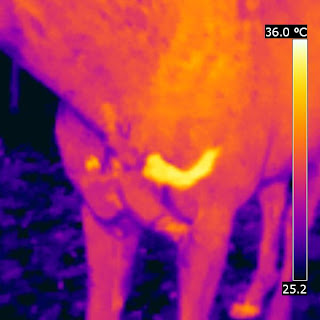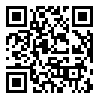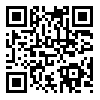Have a look at how to go green, and save money by seeing the invisible world through a FLIR Infrared Camera. No other method of non-destructive testing can reveal what infrared can. A simple scan of your home can reveal many problems you never knew existed.
Plumbing leaks behind walls, water intrusion, energy loss, air intrusion and uneven heat distrubition are just a few of the items that infrared can show instantly in an image.
Check out the video about the FLIR Infrared Cameras.
Back to Advanced Energy Solutions Main Site
16.4.10
13.4.10
Spontaneous Combustion: Hay Fires- Thermal Imaging
The following is directly from the Ontario Ministry of Agriculture Food & Rural Affairs Ontario.
Lives have been lost and hay crops destroyed because of fires caused by spontaneous combustion. This year has been particularly bad for hay heating due to the hot humid weather. If the hay crop is put into the mow above 20-25% moisture content, spontaneous combustion may occur.
A hay crop that is placed too wet into a mow will heat rapidly. If the mow is so large that heat loss is restricted, the internal temperature will rise. As the temperature rises above 130°F (55°C), a chemical reaction occurs and may sustain itself. This reaction does not require oxygen, but the flammable gases produced are at a temperature above their ignition point. These gases will ignite when they come in contact with the air.
Check your hay regularly. If you detect a slight caramel odour or a distinct musty smell, chances are your hay is heating.
What do you do if you suspect that your hay is heating? First of all, make yourself a simple probe that can be inserted into the hay mass to check the temperature. A probe can be made from a 10 foot piece of electrical tubing. Rivet a hardwood pointed dowel to one end and drill 8 - 3/16 inch diameter holes in the tube just above the dowel. Drive the probe into the hay mass and lower a candy thermometer on a long string into the probe. The thermometer should be left for 10 minutes to ensure an accurate reading.
Watch for the following temperatures:
150°F (65°C) ** Entering the Danger Zone. Check temperature daily.
160°F (70°C) ** Danger! Measure temperature every four hours and inspect mow.
175°F (80°C) ** Call the Fire Department! Wet hay down and remove from the barn.
185°F (85°C) ** Hot Spots and Pockets May be Expected. Flames will likely develop when heating hay comes in contact with the air.
212°F (100°C) Critical! Temperature rise is rapid above this point. Hay will almost certainly ignite.
Caution: Before entering the mow, place long planks on top of the hay. Do not attempt to walk on the hay mass itself. Pockets may have already burned out under the hay surface. Always tie a rope around your waist and have a second person on the other end in a safe location to pull you out should the surface of the hay collapse into a fire pocket.
Extreme caution should be taken when fighting a hay fire if hay has been treated with chemical preservatives. Hay treated with preservatives containing ethoxyquin and BHT (butylated hydroxytoluene) will produce hydrogen cyanide gas at around 240°F (115°C). This gas is very deadly. Additives containing primarily propionic acid to not produce hydrogen cyanide during a fire.
Many farmers sprinkle salt on hay as it is stored, in an effort to prevent hay fires. However, tests have shown that salt has no effect on controlling spontaneous combustion. Dry ice, liquid nitrogen or carbon dioxide gas pumped into the hay will prevent combustion by eliminating the oxygen from the hay mass.
Spontaneous combustion is not an accident. By following good storage practices, not only will spontaneous combustion by avoided, but a higher quality of hay will be obtained.
Thermal Imaging can be utilized to assist in detecting spontaneous combustion temperatures before they become critical.
There are some limitations, as Infrared imaging cannot see within an object; only the infrared radiation measured at the surface. This, however, can be extremely valuable when taking measuerments with a probe. Infrared images of the hay storage can be gathered, from there a decision can be made on where to probe for the HIGHEST temperature possible.
Temperatures within oraganic materials vary greatly, untill now only an educated guess or blind probing would lead to the highest measured temperatures. With the use of infrared, another level of measurement is available; and a targeted strike can be carried out on the danger zones.
Lives have been lost and hay crops destroyed because of fires caused by spontaneous combustion. This year has been particularly bad for hay heating due to the hot humid weather. If the hay crop is put into the mow above 20-25% moisture content, spontaneous combustion may occur.
A hay crop that is placed too wet into a mow will heat rapidly. If the mow is so large that heat loss is restricted, the internal temperature will rise. As the temperature rises above 130°F (55°C), a chemical reaction occurs and may sustain itself. This reaction does not require oxygen, but the flammable gases produced are at a temperature above their ignition point. These gases will ignite when they come in contact with the air.
Check your hay regularly. If you detect a slight caramel odour or a distinct musty smell, chances are your hay is heating.
What do you do if you suspect that your hay is heating? First of all, make yourself a simple probe that can be inserted into the hay mass to check the temperature. A probe can be made from a 10 foot piece of electrical tubing. Rivet a hardwood pointed dowel to one end and drill 8 - 3/16 inch diameter holes in the tube just above the dowel. Drive the probe into the hay mass and lower a candy thermometer on a long string into the probe. The thermometer should be left for 10 minutes to ensure an accurate reading.
Watch for the following temperatures:
150°F (65°C) ** Entering the Danger Zone. Check temperature daily.
160°F (70°C) ** Danger! Measure temperature every four hours and inspect mow.
175°F (80°C) ** Call the Fire Department! Wet hay down and remove from the barn.
185°F (85°C) ** Hot Spots and Pockets May be Expected. Flames will likely develop when heating hay comes in contact with the air.
212°F (100°C) Critical! Temperature rise is rapid above this point. Hay will almost certainly ignite.
Caution: Before entering the mow, place long planks on top of the hay. Do not attempt to walk on the hay mass itself. Pockets may have already burned out under the hay surface. Always tie a rope around your waist and have a second person on the other end in a safe location to pull you out should the surface of the hay collapse into a fire pocket.
Extreme caution should be taken when fighting a hay fire if hay has been treated with chemical preservatives. Hay treated with preservatives containing ethoxyquin and BHT (butylated hydroxytoluene) will produce hydrogen cyanide gas at around 240°F (115°C). This gas is very deadly. Additives containing primarily propionic acid to not produce hydrogen cyanide during a fire.
Many farmers sprinkle salt on hay as it is stored, in an effort to prevent hay fires. However, tests have shown that salt has no effect on controlling spontaneous combustion. Dry ice, liquid nitrogen or carbon dioxide gas pumped into the hay will prevent combustion by eliminating the oxygen from the hay mass.
Spontaneous combustion is not an accident. By following good storage practices, not only will spontaneous combustion by avoided, but a higher quality of hay will be obtained.
Thermal Imaging can be utilized to assist in detecting spontaneous combustion temperatures before they become critical.
There are some limitations, as Infrared imaging cannot see within an object; only the infrared radiation measured at the surface. This, however, can be extremely valuable when taking measuerments with a probe. Infrared images of the hay storage can be gathered, from there a decision can be made on where to probe for the HIGHEST temperature possible.
Temperatures within oraganic materials vary greatly, untill now only an educated guess or blind probing would lead to the highest measured temperatures. With the use of infrared, another level of measurement is available; and a targeted strike can be carried out on the danger zones.
11.4.10
Intro to Energy Audits Video- Thermal Camera
This video has a good overall representation what a Thermal Imaging Survey can do for you in your efforts to save money.
Labels:
Save Money,
Thermal Camera,
Thermal Dynamics,
Thermal Imaging
5.4.10
Cut your heating bill with Thermography- News Coverage
Illustrates how a home Thermographic survey can save a homneowner money on their utility bills.
Labels:
Thermal Dynamics,
Thermal Imaging,
Thermography
4.4.10
Equine Infrared Pictures- Fluke the horse...
Our subject today is a 21-year-old Arabian horse named Fluke (no connection with the brand). He proved to be a more than willing subject for some Thermal Imaging. An overall scan of his entire body was carried out, as well as some focus on areas of current issues.
During the winter months our subject lost some hair where his blanket caused some minor irritation. Our goal was to inspect these areas to ensure the healing process is still progressing without issue.
As well, Fluke has possessed a club-foot all of his life. Although he does not display any signs of discomfort whatsoever, we were curious to see if any underlying inflammation would be present. We performed a comparison with his other limbs and were quite thrilled to discover that there was virtually no sign of increased or decreased blood flow to that area. It appears as though his body had compensated extremely well.
Below are a few images of our happy subject on a fine spring day.
During the winter months our subject lost some hair where his blanket caused some minor irritation. Our goal was to inspect these areas to ensure the healing process is still progressing without issue.
As well, Fluke has possessed a club-foot all of his life. Although he does not display any signs of discomfort whatsoever, we were curious to see if any underlying inflammation would be present. We performed a comparison with his other limbs and were quite thrilled to discover that there was virtually no sign of increased or decreased blood flow to that area. It appears as though his body had compensated extremely well.
Below are a few images of our happy subject on a fine spring day.
Happy Boy
Curious about the camera
What Infrared sees
His patch healing nicely
Happy feet
Happy legs too...
Labels:
Equine Imaging,
Horse Imaging,
Infrared,
Thermal Imaging
Subscribe to:
Posts (Atom)

